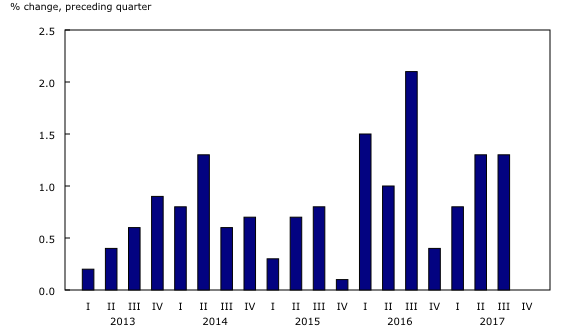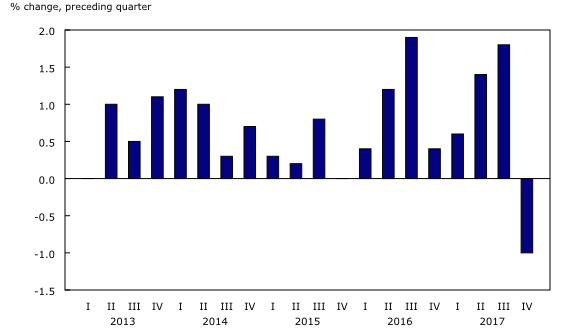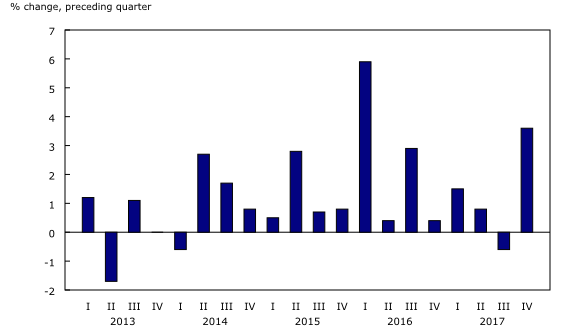National tourism indicators, fourth quarter 2017
Archived Content
Information identified as archived is provided for reference, research or recordkeeping purposes. It is not subject to the Government of Canada Web Standards and has not been altered or updated since it was archived. Please "contact us" to request a format other than those available.
Released: 2018-03-28
$21.7 billion
Fourth quarter 2017
-0.0% 
(quarterly change)
Tourism spending in Canada was unchanged in the fourth quarter, following 1.3% growth in each of the previous two quarters. Increased spending by international visitors to Canada was offset by a decline in tourism spending by Canadians at home.
Tourism spending by Canadians decreases
Tourism spending by Canadians in Canada decreased 1.0% in the fourth quarter, after a 1.8% increase in the previous quarter.
The decline in spending was broadly distributed across tourism goods and services. Accommodation (-2.1%), air passenger transport (-0.8%), vehicle fuel (-1.4%), pre-trip expenditures, such as luggage and motor homes (-2.7%), and food and beverage services (-1.0%) all contributed to the decline.
Overall growth in household spending on tourism-related services such as transport, food and beverage, and accommodation all slowed in the fourth quarter, contributing to lower domestic tourism demand.
Tourism spending by international visitors rises
Spending by international visitors to Canada (+3.6%) rose sharply in the fourth quarter, following a weak third quarter (-0.6%).
The growth was driven by increased visitor spending on air passenger transport (+5.0%), accommodation (+4.2%) and food and beverage services (+4.0%). In decline were outlays on interurban bus transport (-2.2%) and vehicle fuel (-0.8%).
Overnight travel from abroad increased in the fourth quarter, while same-day car travel from the United States was down.
Tourism gross domestic product edges up
Tourism gross domestic product (GDP) edged up 0.1% in the fourth quarter, after increasing 0.9% in the previous quarter. Economy-wide GDP increased 0.4% in the fourth quarter.
Growth in tourism GDP was driven mainly by transportation industries (+1.1%). Tourism GDP of accommodation (+0.2%) and food and beverage services (+0.2%) also increased.
Tourism employment was flat in the fourth quarter, following 0.5% growth in the third quarter. Tourism employment grew in recreation and entertainment (+0.9%), air transportation (+0.5%), accommodation (+0.1%) and food and beverage services (+0.1%) industries, while it declined in travel services (-1.8%) and other transportation (-0.3%).
Annual 2017
Tourism spending in Canada grew 4.1% in 2017, following a similar increase (+4.2%) in 2016. Growth resulted mainly from strength in the second and third quarters. Expenditures by both Canadians at home and international visitors contributed to the rise.
Spending by Canadians at home increased 4.0%, after a 2.8% gain in 2016. Growth was largely attributable to passenger air transport (+10.7%). Increases in non-tourism goods and services (+3.4%) and food and beverage services (+2.2%) also contributed to the gain.
Spending by international visitors rose 4.6%, as travel from abroad was up in 2017. However, this relatively strong gain was less than half the 9.7% increase in 2016.
Growth in spending by international visitors was primarily driven by increased passenger air transport (+10.2%), accommodation services (+3.9%) and food and beverage services (+4.5%), while spending on interurban bus transport (-2.9%) and vehicle fuel (-0.4%) declined.
Tourism GDP rose 3.7% in 2017, the same pace as in 2016. Transportation (+8.5%) and accommodation (+3.0%) were the main contributors to the increase. Economy-wide GDP rose 3.0% in 2017.
There were 1.9% more tourism jobs in 2017, the same rate of growth as the previous year. Food and beverage services (+2.5%), accommodation (+1.9%) and air transportation (+2.8%) industries all contributed to the rise. Economy-wide, employment increased 1.9% in 2017.
Sustainable development goals
On January 1, 2016, the world officially began implementation of the 2030 Agenda for Sustainable Development, the United Nations' transformative plan of action that addresses urgent global challenges over the next 15 years. The plan is based on 17 specific sustainable development goals.
The national tourism indicators are an example of how Statistics Canada supports the reporting on the Global Goals for Sustainable Development. This release will be used in helping to measure the following goal:

Note to readers
Growth rates for tourism spending and gross domestic product (GDP) are expressed in real terms (that is, adjusted for price changes), at 2007 constant prices, as well as adjusted for seasonal variations, unless otherwise indicated. Employment data are also seasonally adjusted. For information on seasonal adjustment, see Seasonally adjusted data – Frequently asked questions.
Economy-wide GDP is obtained from CANSIM table 380-0064. Economy-wide employment is obtained from CANSIM table 383-0012.
Associated percentage changes are presented at quarterly rates unless otherwise noted.
The national tourism indicators are funded by Destination Canada.
Next release
Data on the national tourism indicators for the first quarter will be released on June 27.
Products
The Latest Developments in the Canadian Economic Accounts (13-605-X) is available.
The User Guide: Canadian System of Macroeconomic Accounts (13-606-G) is also available. This publication will be updated to maintain its relevance.
The Methodological Guide: Canadian System of Macroeconomic Accounts (13-607-X) is available.
The System of Macroeconomic Accounts module features an up-to-date portrait of national and provincial economies and their structures.
Contact information
For more information, or to enquire about the concepts, methods or data quality of this release, contact us (toll-free 1-800-263-1136; 514-283-8300; STATCAN.infostats-infostats.STATCAN@canada.ca) or Media Relations (613-951-4636; STATCAN.mediahotline-ligneinfomedias.STATCAN@canada.ca).
- Date modified:




